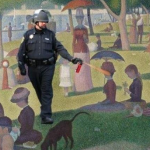webarts
Platforms,Tools and the Vernacular Imaginary

After having lived through three generations of electronic literature, and having experienced pre-web, web, and post-web literary periods, Will Luers takes a step back and advocates an "independent digital culture" in which literary artists might explore "a reality between language and the ineffable (be it artistic, religious or secular)." A mixture of technics and magics, we may be approaching a fourth generation of e-lit that is closer to pre-industrial folklore than it is to our present, technically managed space for individual and collective "creativity."
In Conversation with the Decameron 2.0

Jin Sol Kim and Lulu Liu interview the Decameron 2.0, a Canadian collaborative made up of professors and artists who are inspired by Giovanni Boccaccio’s plague narrative The Decameron (1348-1353) to develop creative works during and in response to the COVID-19 pandemic.
Researching Writing Technologies through the Speculative Prototype Design of Trina

Burdick situates the speculative software prototypes of Trina: A Design Fiction as design-theory hybrids that can expand our understanding of critical making and critical design. The essay offers four readings of the Trina prototypes, designed as research into speculative writing technologies that are situated and embodied. The essay concludes with the introduction of an “Indexical Reader,” a design concept for close and distant reading in the Humanities.
A Better Mao’s Trap
Infiltrate, animate, dominate. Lisette Gonzales reviews Derek Pell's Little Red Book of Adobe LiveMotion.
An American Art Critic in Paris: a nigtmare with and about John Brunetti
>--> Chicago art critic John Brunetti reviews The Truth on Tape, a survey of Daniel Wenk's art